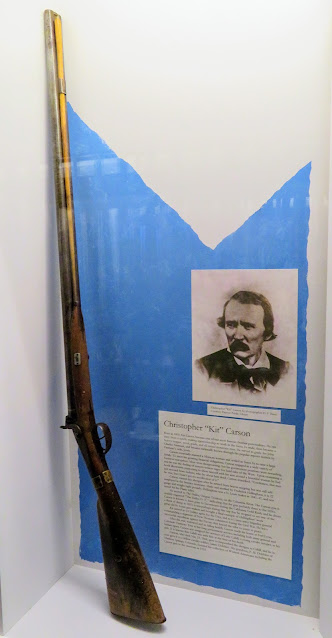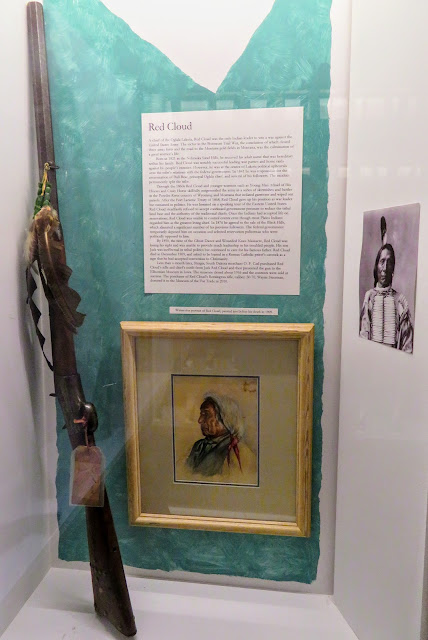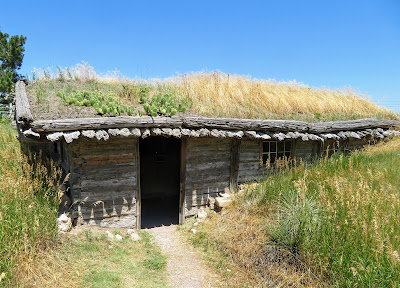…continuing with our July road trip through northern and western Nebraska to include more highlights of our exploration of the Museum of the Fur Trade near Chadron.
As I’d mentioned in the previous post, the Native American artifacts on display at this museum is both extensive in quantity and impressive as regards quality. This spectacular Sioux woman’s blue dress features a collar piece or yoke made up with 4,000 detanlia shells!
Dentalium
or detanlia shells were an international trade item among the Inuit, First
Nations and Native Americans.
Traditionally, the shells of the mollusk Dentalium pretiosum were
harvested from deep waters around the western coast of what is now Canada as
well as the northwest coast of the USA.
Among the Plains Indians, dentalium shells have long been associated
with wealth. In addition to the yokes on
women’s dresses, they were used on capes, as hair ornaments, necklaces and as
dangling earrings.
This large exhibit area has been added to the Museum of the Fur Trade since we last visited it over 35 years ago. That reproduction 36 foot long trading canoe is pretty impressive. I can imagine a group of fur traders with 3 or 4 of these canoes loaded with furs and skins headed downriver to Ft. Pierre… It must have been a hard way to make a living.
Many trade items are on display in this large hall. Of interest to me were these displays of tobacco products. Sorry for the glare on the first photo. I would have left it out except for the fact that I’d never seen tobacco packaged like this… These solid packages of tobacco are very rare and most collectors are elated if they can even secure pieces of the foil bands. They were produced by the Lorillard Tobacco Company. That company was founded in New Jersey in 1760 and was purchased in 2014 by Reynolds American for $27 billion.
The
second photo shows a variety of tobacco products, ranging from small twists (referred
to as pig or hog tails), to rope tobacco and cigars. Rope or twist tobacco was made with deveined
leaves spun into rope, then ‘dressed’ in molasses or other flavoring to
preserve them. They were frequently
shipped in 90 lb. rolls.
While
many varieties of native tobacco were used by Native Americans prior to the
arrival of the Europeans, the latter introduced a more commercial type that was
grown in Brazil. Both men and women
smoked to relax and tobacco was used in ceremonies and to initiate or conclude
treaty negotiations or trading sessions.
It was a favorite gift for a trader to give when dealing with his Indian
trading partners.
Since my mother was a weaver and she wove many sashes, these beauties caught my eye. Great Lakes Native peoples started buying many shades of dyed yarn from French traders and then wove the yarn into exquisite sashes, bags, garters, straps and belts. In turn, these items became part of the trade business.
Other items
on display in this large hall include gunpowder…complete with powder horns,
tins and barrels for powder trading as well as a display of powder grades. In addition there is a display of different
types of flints that could be used in the old flintlock rifles. I also noted a 25 unopened bags of .40
caliber lead balls and a huge display of iron and copper trade kettles. Another display includes the oldest known
American made beaver trap…made in 1755.
This canoe built in 1870 by Penobscot Indians from Maine caught my eye. The Penobscot peoples from the Northeastern Woodlands Region began trading with the Europeans in the 1500s…and they were steadily forced off their lands. Today they are organized as a federally recognized tribe in Maine and as a First Nations band government in Canada’s Atlantic Provinces as well as Quebec. About 2,300 Penobscot tribal members are listed in the USA.
There are plenty of antique and historical firearms, mostly long guns, on display at the Museum of the Fur Traders, enough to satisfy even the most avid weapons collector or historian. This pair of pistols belonged to a Hudson’s Bay officer. They were made by Phillip Bond, a Hudson’s Bay Company gun inspector or ‘viewmaster’.
This is a rather spectacular trade item… This handsome chest is full of freshwater pearls from the Tennessee River. These pearls were quite popular among early colonialists. Native Americans along the Tennessee River valley gathered them and traded them to obtain goods from both Spanish and French traders.
This photo with all its glare and reflection, gives the viewer an idea of the number of long rifles on display in what I can only describe as an almost overwhelming antique arsenal. To be clear, weapons are also displayed throughout the museum as they were key to trading, hunting, self-defense, inter-tribal warfare and battles between the European traders and the Native Americans. In total, the long gun…the northwest trading gun collection…at the museum includes weapons dating from 1640 through 1911…
Several
historic owner specific rifles are on display.
This weapon belonged to the famous Shawnee Chief, Tecumseh. (1768 –
1813) Shipments of shorter ‘chief’s guns’ began arriving from England in
1811. At least 6,000 of these flintlock
muskets were distributed by the British to their Native American allies. The British Indian Department depot at
Amherstburg on the Detroit River gave Tecumseh his weapon. During the War of 1812, the Shawnee fought
with the British against the Americans in several battles. He even fought with the British fleet on Lake
Erie as a sharpshooter.
Tecumseh
was killed in the Battle of the Thames in late 1813. This battle is also known as the Battle of
Moraviantown. It resulted in an American
victory in the War of 1812 against Tecumseh’s Confederacy, (an alliance
including several thousand warriors), and their British allies. The British lost control of southwestern
Ontario as a result of the battle…and the Confederacy fell apart.
This shotgun belonged to one of America’s most famous frontier personalities, Christopher “Kit” Carson. (1809 – 1868) He did it all…a trapper, scout, mountain man, US Indian Agent and as a Brigadier General leading a regiment of New Mexican volunteers during the American Civil War. Carson was a favorite with eastern writers who were eager for sensational stories about the American west. He did nothing to deny many of the adventures credited to him…
The
shotgun was made and marked by James Heilinghaus, a respected gun maker from
St. Louis Missouri. It is a 22 gauge
shotgun and it weighs 8 pounds. As a Civil
War General and Indian Agent, Kit had been given the services of an aide and it
was well documented that as Carson’s health declined, he presented the shotgun
to that aide.
This Remington .50-70 caliber rifle belonged to Red Cloud, Chief of the Oglala Sioux. (1821 – 1909) Red Cloud, who was born in the Sand Hills in what is now Nebraska, was the only Indian leader to win a war against the US Army. He was the victor in the Bozeman Trail War. As the result, 3 army forts were closed and destroyed and the trail to the Montana gold fields was shut down.
In the
1860’s, accompanied by younger warriors such as Young Man Afraid of His Horse
and Crazy Horse, Red Cloud repeatedly outgeneraled the US army in a series of skirmishes
and running battles. Finally, as per the
Treaty of Fort Laramie in 1868, he gave up his position as war chief. He went on a speaking tour of the eastern
United States where he gained much popularity.
His son was with Red Cloud when he died in December of 1909. Two months later, Jack Red Cloud sold this
rifle to a South Dakota merchant…and after a string of donations, it ended up
in the collection here at the Museum of the Fur Trade.
FYI…the
carbine owned by Young Man Afraid of His Horse, another respected Sioux leader,
is also on display at the museum as are many weapons from Canada’s frontier
history and the battles between that country’s First Nation people and the
Canadian government.
What you see here is what the original trading post at this site looked like. Although this is a reconstruction, the original post holes and layout were faithfully followed. The land itself is considered to be a historic archeological site.
The
original trading post was established for trade with the Brule Sioux Indians in
1840. The post was operated by James
Bordeaux and his 2 Brule wives every winter until 1849 when Bordeaux moved on
to Wyoming where he had a stock operation, a ranch and a store. However, in 1850 operation of this trading post
was taken over by Francois Boucher, the son-in-law of Spotted Tail the head
chief of the Brule Sioux. For several
years, Boucher apparently provided the Sioux with rifles and ammunition…almost
certainly contributing to the defeat of Custer and the Seventh Cavalry at the
Little Big Horn. The trading post was
closed after the US Army caught Boucher with 50,000 rounds of ammunition…
Well,
that’s about it for our exploration of the Museum of the Fur Trade. This is a compact but well organized world
class museum that’s located in the far northwestern corner of Nebraska. The museum features over 6,000 primary
artifacts that have been gathered and donated over time. It is home to the most complete collection of
historical items covering the fur trade period of commerce.
The Museum
of the Fur Trade is located at 6321 US Hwy 20 just 3 miles east of Chadron
Nebraska and just 60 miles south of South Dakota’s Black Hills. The museum is open daily from 8 AM to 5 PM from
May 1 through October 31. Appointments
are required during the winter months.
Phone: 308-432-3813. Did I
mention that entrance to this museum is a true bargain?! Persons over 18 are charged $5.00 each… Check
out the museum and its exhibits at Chadron, Nebraska |
American History | Museum of the Fur Trade. Laurie and I feel that this is one of the
best relatively small museums in the USA…5 stars for sure!
Just
click on any of the photos to enlarge them…
Thanks for
stopping by for a visit!
Take
Care, Big Daddy Dave














Love that collar piece with shells, really special! Pearls are so beautiful too.
ReplyDeleteHow interesting...learning about all the weapons, the trade goods, and the battles fought by the owners of those guns. Thanks! I dare say I'll never make it to that museum, so your descriptions are just great!
ReplyDelete